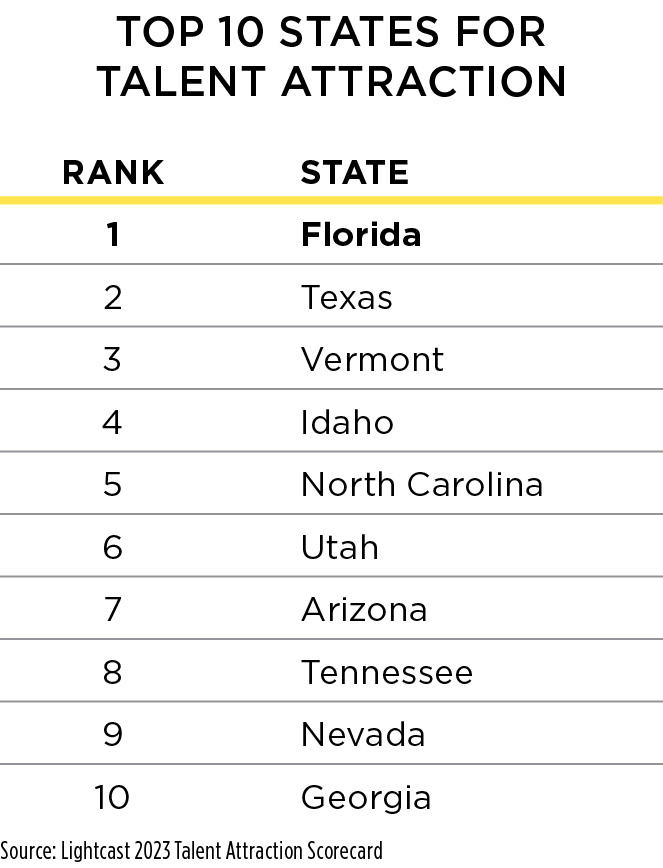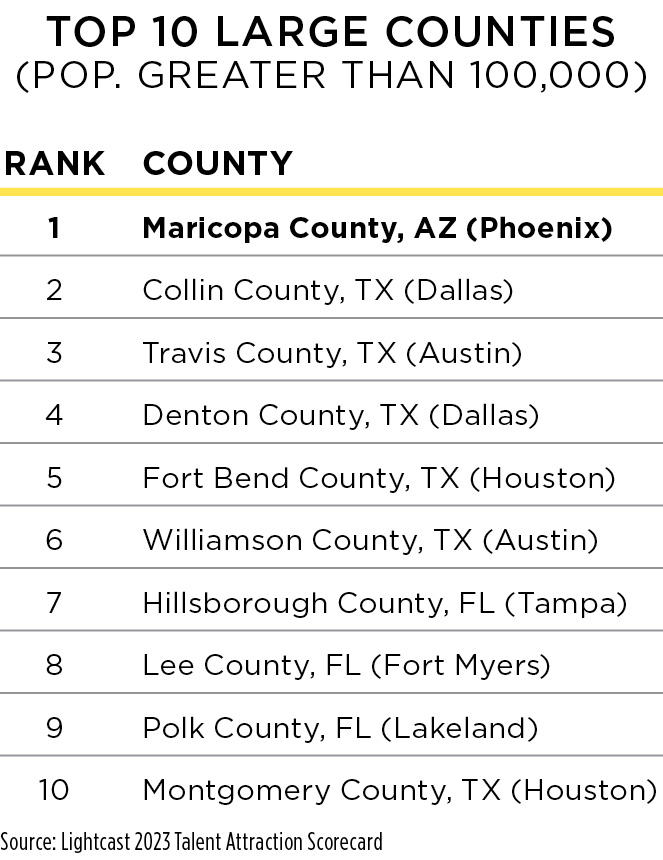Florida, Texas and Vermont — the latter confounding traditional patterns — lead the nation in attracting and keeping talent, according to a study just published by data organization Lightcast. Driven, says Lightcast, by “the ongoing impact of post-COVID worker migration,” Vermont vaulted to its No. 3 ranking from No. 30 in 2022.
“Vermont leads in talent migration, driven by an influx of remote workers from neighboring states. This underscores the far-reaching influence of post-COVID patterns on shaping opportunities for communities eager to attract growth,” said Josh Wright, executive vice president of Growth at Lightcast.
Beyond the Vermont surprise, the Lightcast study released December 7 is a model of consistency, with Florida and Texas holding serve from their previous rankings. And once again, states from the Southeast (4) and Southwest (3) factor heavily in the annual report’s top 10, which again includes two states from the Mountain West. Idaho, North Carolina, Utah, Arizona, Tennessee, Nevada and Georgia round out the top 10. All but Vermont and Georgia retained top 10 rankings from 2022.
Among large counties (population 100,000 or greater), Maricopa County, Arizona (Phoenix), Collin County, Texas (Plano) and Travis County, Texas (Austin), reprise their 2022 rankings as 1-2-3. Six of the top 10 large counties are in Texas, and three are in Florida: Hillsborough County (Tampa), Lee County (Fort Myers) and Polk County (Lakeland).
Joining Vermont as new to the top 10 for talent migration, Kentucky and Missouri buck the ongoing trend of talent flowing to the Sunbelt, the Southeast in particular.
“The Southeast was buoyed by its strong performance. Five of the top 10 states for migration are Southeastern: Florida, North Carolina, Tennessee, South Carolina, and Georgia,” said Lightcast in a release.
Results such as these come as no surprise to veteran site consultants such as Courtney Dunbar, director of site selection for Burns & McDonnell, the Kansas City-based engineering, architecture and construction company.
“Not many people want to live where it’s 40 degrees below zero,” she says. “What’s happening is people are first making decisions as to where they want to live, and then they take the job.”
 Maricopa County Still Rules
Maricopa County Still Rules
Maricopa County, anchored by Phoenix, has ranked No. 1 for talent attraction for six of the last eight years. With companies like Taiwan Semiconductor Manufacturing Co., Intel and LG Energy Solution investing billions into the Phoenix region, the metro was recently selected by the Biden Administration as one of five national Workforce Hubs, through which the federal government is partnering with state and local officials, employers, unions, community colleges, high schools and other stakeholders to promote “a diverse and skilled workforce” in industries that include semiconductors, electric vehicles and renewables.
Mesa, after Phoenix the second-largest city in top-ranked Maricopa County, has placed an impressive 56 new projects since 2019 in Site Selection’s database of major corporate investments, and racked up $1.56 billion in capital investments during the most recent fiscal year, according to Jaye O’Donnell, economic development director for the city.
“What we have heard from companies who have located here or expanded here is that Maricopa County in general is a really great place to recruit talent,” says O’Donnell. “They’re finding talent that exists here already, and if they need to bring in additional talent it’s easy for them to recruit employees to Arizona and then to retain them here.”
And why is that?
 “Skilled employees who are in Arizona,” believes O’Donnell, “enjoy that type of lifestyle that Arizona has to offer. It’s an easy state to find a work life balance. You can work hard and play hard. You have national sports teams. You have outdoor recreation and adventure activities. We also have some of the best golf in the country and a really good performing arts and music scene.”
“Skilled employees who are in Arizona,” believes O’Donnell, “enjoy that type of lifestyle that Arizona has to offer. It’s an easy state to find a work life balance. You can work hard and play hard. You have national sports teams. You have outdoor recreation and adventure activities. We also have some of the best golf in the country and a really good performing arts and music scene.”
The Phoenix region boasts three professional sports teams — the Cardinals of the NFL, baseball’s World Series runner-up Diamondbacks, and the Coyotes of the NHL — all of which boast dedicated fan bases. The region’s desert landscape supports unique recreational activities from rock climbing to rafting to off-road biking and hiking, all immensely attractive not just to the coveted younger generations but also to the types of workers recruited by companies such as Virgin Galactic, XNERGY, Hyundai, Amazon, Google, Benchmark Electronics and JX Nippon, all of which have made investments in Mesa over the past fiscal year.
Different Strokes, Different Folks
According to Lightcast, Maricopa County ranked No. 3 among large counties for in-migration. But, says Burns & McDonnell’s Dunbar, leveraging talent in the name of economic development is about much more than mere numbers. Texas, Georgia, Virginia and Oklahoma, she says, rank high for workforce development programs. And it gets more granular, still.
“We’re going to look at the quality of the population,” Dunbar says. “When we ascertain workforce quality, we will look at crime stats, number one, because usually there’s a correlation. If you have a lot of crime or unrest, that’s going to impact a community adversely versus those that seem harmonious. We also know the regions that have drug use issues based upon CDC statistics and other types of information.”
What motivates people to move, or to stay where they are, is shifting by generation. Yes, Florida and Texas, the top two states for in-migration, assess no personal income taxes. But that, says Dunbar, matters more to some than others.
“The older generation, the one that’s closer to retirement, they care,” she says. “Younger kids, they’re not even paying attention to it. They’re going where they want to go because of the recreational, social, civic scenes and the weather. The side benefit to that,” she believes, “is the more population you get, the more capable you are of providing those concessions.”

